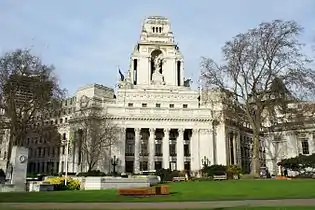Tower Hill
The name Tower Hill is primarily applied to the high ground just north of the Tower of London moat, in the London Borough of Tower Hamlets.


The land was historically part of the Liberties of the Tower of London; the Tower needed control of the area to keep it clear of any development which would reduce the defensibility of the Tower. Building has encroached to a degree, but a legacy of this control is that much of the hill is still open. The hill includes land on either side of the former London Wall, with a large remnant is still visible.[1]
For centuries, the hill hosted public executions, particularly of attainted peers and today it is notable for being the site of the Tower Hill Memorial in its Trinity Square Gardens which are adjoined by its two smaller public gardens, Wakefield and Tower Gardens. The latter are lined by a web of pavements which cut short Trinity Square, rendering it a curved park-lined street.
Location
The set of gardens and buildings surrounding are served by Tower Gateway DLR and Tower Hill tube stations. The street Tower Hill forms an edge of the congestion charging zone between Byward Street in the west and a junction with Minories and Tower Hill Terrace in the east.
History


Settlement
In one of the oldest parts of London, archaeological evidence shows that there was a settlement on the hill in the Bronze Age and much later a Roman village that was burnt down during the Boudica uprising. A nearby church, All Hallows-by-the-Tower, is known for fragments of Romanesque architecture dating back to AD 680; the church itself dates from 675.
Local government
Great Tower Hill was an extra-parochial area[1] within the Tower Liberty, under the direct administrative control of the Tower of London and outside the jurisdiction of the City of London and the county of Middlesex. In 1855 the area became part of the district of the Metropolitan Board of Works.
The "District of Tower" became part of the Whitechapel District, under the authority of the Whitechapel District Board of Works. This was ambiguous and The Great Tower Hill Act 1869 was required to explicitly interpret it as Old Tower Without, including within it Great Tower Hill.[2] The Tower Liberty was abolished in 1894 and incorporated into the County of London.
Executions
Public executions of high-profile traitors and criminals were often carried out on Tower Hill, including:
- 1381 – Simon Sudbury, Archbishop of Canterbury[3] (beheaded by an angry mob)
- 1381 – Sir Robert Hales[3]
- 1388 – Sir Simon de Burley[3]
- 1388 – John de Beauchamp, 1st Baron Beauchamp (fourth creation)
- 1397 – Richard Fitzalan, 11th Earl of Arundel[3]
- 1440 – Rev. Richard Wyche, Vicar of Deptford[3]
- 1462 – John de Vere, 12th Earl of Oxford[3]
- 1462 – Aubrey de Vere, eldest son and heir of John de Vere, 12th Earl of Oxford
- 1462 – Sir Thomas Tuddenham
- 1462 – William Tyrrell
- 1462 – John Montgomery
- 1470 – John Tiptoft, 1st Earl of Worcester[3]
- 1495 – Sir William Stanley[4]
- 1497 – James Tuchet,[4] a commander of the Cornish Rebellion of 1497
- 1499 – Edward Plantagenet, 17th Earl of Warwick[4]
- 1502 – James Tyrrell
- 1510 – Edmund Dudley
- 1510 – Sir Richard Empson
- 1521 – Edward Stafford, 3rd Duke of Buckingham[4]
- 1535 – John Fisher, Bishop of Rochester[4]
- 1535 – Sir Thomas More,[4] ex-Lord Chancellor
- 1536 – George Boleyn, brother of Anne Boleyn
- 1537 – Thomas Darcy, 1st Baron Darcy de Darcy[4]
- 1538 – Henry Courtenay, Earl of Devon[5]
- 1538 – Edward Neville
- 1539 – Sir Nicholas Carew
- 1540 – Thomas Cromwell, Earl of Essex[5]
- 1540 – Walter Hungerford, 1st Baron Hungerford of Heytesbury[6]
- 1547 – Henry Howard, Earl of Surrey[5]
- 1549 – Thomas Seymour, 1st Baron Seymour of Sudeley
- 1552 – Sir Ralph Vane
- 1552 – Sir Thomas Arundell of Wardour Castle
- 1552 – Edward Seymour, 1st Duke of Somerset[5]
- 1554 – Sir Thomas Wyatt[5]
- 1554 – Lord Guildford Dudley
- 1572 – Thomas Howard, 4th Duke of Norfolk[5]
- 1601 – Sir Christopher Blount
- 1615 – Sir Gervase Helwys
- 1631 – Mervyn Tuchet, 2nd Earl of Castlehaven
- 1641 – Thomas Wentworth, 1st Earl of Strafford[5]
- 1645 – William Laud, Archbishop of Canterbury[7]
- 1651 – Christopher Love, Presbyterian minister
- 1662 – Sir Henry Vane[7]
- 1683 – Col. Algernon Sidney[7]
- 1685 – James Scott, 1st Duke of Monmouth[7]
- 1716 – James Radclyffe, 3rd Earl of Derwentwater[7]
- 1716 - William Gordon, 6th Viscount of Kenmure[8]
- 1746 – William Boyd, 4th Earl of Kilmarnock
- 1746 – Robert Boyd (of Clan Boyd)
- 1746 – Arthur Elphinstone, 6th Lord Balmerino
- 1747 – Simon Fraser, 11th Lord Lovat[7]
References
- Wheatley, Henry Benjamin; Cunningham, Peter (1891). "Tower Hill". London Past and Present. vol. 3. London: John Murray. pp. 400–402.
- The Statutes of the United Kingdom of Great Britain and Ireland, Great Britain, His Majesty's Statute and Law Printers, (1869)
- Sign at site of the scaffold (2)
- Sign at site of the scaffold (3)
- Sign at site of the scaffold (4)
- "Walter Hungerford and the 'Buggery Act' | English Heritage". www.english-heritage.org.uk. Retrieved 20 March 2017.
- Sign at site of the scaffold (5)
- https://archive.org/stream/scotspeeragefoun05pauluoft#page/128/mode/2up
External links
 Media related to Tower Hill at Wikimedia Commons
Media related to Tower Hill at Wikimedia Commons


